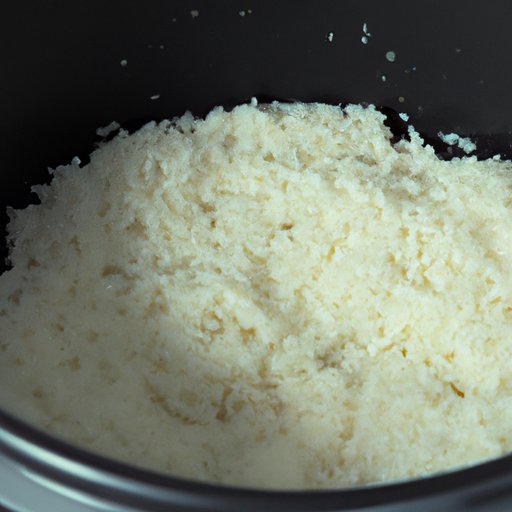I. Introduction
Have you ever struggled with cooking the perfect rice on the stovetop? Fret no more, as we’re here to guide you on mastering the art of cooking rice in a rice cooker. Whether you’re a busy college student, a working parent, or a cooking enthusiast, a rice cooker is an appliance that can make your life easier in the kitchen. In this article, we will explore the best practices and tips to make perfectly cooked rice in your rice cooker every time!
II. Mastering Rice Cooker Cooking: A Step-by-Step Guide to Cooking Fluffy, Perfect Rice
When it comes to cooking rice in a rice cooker, it’s important to follow the instructions provided by the manufacturer. This will ensure that you can obtain the ideal texture of rice. Some rice cookers may require different measurements, settings, and timings. Always take note of the rice-to-water ratio, as different types of rice may require varying amounts of liquid.
For standard white rice, the usual ratio is 1:1.5 cups of rice to water. Measure the rice using a cup or scoop that comes with your rice cooker. Rinse the rice in cold water until the water runs clear, then let it sit in a bowl of water for 10-15 minutes. This process allows the rice to absorb water and soften faster during cooking. Drain the rice from the bowl before placing it in the rice cooker.
Before cooking, make sure the rice cooker is clean and dry. Add the rice and water to the rice cooker pot, snap on the lid, and press the “cook” button or “start” button, depending on the model of your rice cooker. Wait until it switches to the “warm” setting, indicating that the rice is fully cooked. Let it sit with the lid on for a few minutes to steam and fluff up the rice.
III. 5 Tips to Achieving Perfectly Cooked Rice Every Time with Your Rice Cooker
1. Use high-quality rice and water. The quality of ingredients matters when it comes to cooking any dish, including rice. Choose premium rice, which can make a big difference in taste and texture. Water is also important, so consider using filtered or bottled water to avoid any impurities that may affect the taste.
2. Soak rice before cooking. Soaking rice is an optional step, but it can help reduce cooking time and make the rice fluffier. Simply cover the rice with water and let it sit for 10-15 minutes before draining.
3. Wash rice to remove excess starch. Rinsing the rice before cooking can help remove excess starch and prevent clumping. Use a fine-mesh strainer and rinse the rice under cold running water until the water runs clear.
4. Add flavor to the rice. You can enhance the taste of rice by adding some herbs, spices, or broth while cooking. Experiment with different flavors to see what works best for you.
5. Use the right settings for different types of rice. Different types of rice (e.g. brown, jasmine, sushi, basmati) may require different settings on your rice cooker. Refer to the instructions for the recommended settings, or experiment with different settings to see what works best for you.
IV. Effortless Rice Cooking: How to Use a Rice Cooker for Delicious and Healthy Rice Dishes
Using a rice cooker has many benefits over traditional stovetop methods. For one, it saves time and requires minimal effort. With a rice cooker, you can cook other grains such as quinoa, couscous, and oats. You can also use it to prepare different rice dishes, such as risotto, paella, or fried rice.
Adding vegetables and protein to your rice is a great way to make a complete meal. Consider adding diced carrots, peas, or bell peppers. You can also add lean protein such as chicken, tofu, or shrimp. Add some herbs and spices to enhance the flavor of your dish.
V. The Ultimate Guide to Cooking Rice in a Rice Cooker: How to Choose the Right Rice and Cook It to Perfection
There are many different types of rice available in the market, each with its unique flavor and texture. Jasmine rice is soft and fragrant, while sushi rice is sticky and firm. Basmati rice is long-grain and nutty, while brown rice is chewy and nutty. Choosing the right rice can make a significant difference in the end result of your dish.
When cooking specialty rice such as brown or wild rice, the rice-to-water ratio may be different than standard white rice. Brown rice requires more water and a longer cooking time. You may also need to soak it overnight before cooking to reduce cooking time.
VI. Rice Cooker Hacks: Sneaky Secrets for Cooking Perfect Rice in a Snap
Your rice cooker can do more than just cook rice. You can use it for cooking other grains such as quinoa, bulgur, or couscous. Add the grain and water to the pot, set the timer, and let it do its thing. You can also use your rice cooker to make breakfast dishes such as oatmeal and grits. Simply add the grains, milk, and any additional flavorings, such as cinnamon or maple syrup, to the pot, and let it cook on the porridge or oatmeal setting.
Make sure to clean your rice cooker after every use. Wipe the pot with a damp cloth and avoid using abrasive cleaners that may damage the non-stick coating. Store your rice cooker in a dry, cool place to avoid affecting its performance.
VII. Conclusion
Cooking rice in a rice cooker is a simple and effortless way to make fluffy, perfect rice every time. By following the instructions and tips outlined in this article, you can elevate your rice game and experiment with different rice dishes. Whether you’re a beginner or a seasoned cook, a rice cooker is an essential appliance to have in your kitchen.
